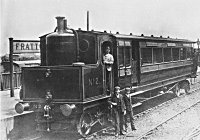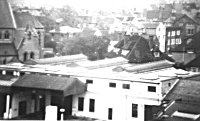
When the first scheduled train service arrived on Portsea Island in 1847 it terminated at Portsmouth Town Station. This was not the choice of the owners but came about because at that time the towns of Old Portsmouth and Portsea were protected by lines of fortification and the military authorities would not allow them to be breached. One consequence was that the rail service could not connect directly with the Isle of Wight steamers which left from Portsmouth Harbour. In 1861 Southsea (later Clarence) Pier opened to allow a second point of embarkation for travellers going to the Isle of Wight but it was hardly practicable to extend the railway through to link up with the ships calling there.

A breakthrough of sorts occurred around 1876 when the new South Parade Pier was opened. When it too began a service to the Island an opportunity arose for the railway to be linked by branching the main Portsmouth to London line on a spur into the heart of Southsea. The original plan was for the Southsea branch to set out from a new station at Copnor, but this was later revised under pressure from the two rail companies who operated the main line who preferred a station at Fratton.

Work on building the branch line began in March 1884 with the first sod being ceremoniously cut by Her Royal Highness Princess Edward of Saxe-Weimar. By July 1885 the 1¼ mile track was ready for use. The line terminated at Southsea Station which was constructed at Granada Road, adjacent to the Granada Inn. It was opened by Lady Willis, wife of the Lieutenant Governor of Portsmouth, on 1st of July 1885.
At the time of its construction there were relatively few houses to by-pass but it did have to cross three important roads. It was therefore necessary to construct road bridges at Goldsmith Avenue, Jessie Road and Albert Road. Originally the railway had no stpping points between Fratton and Southsea, but by 1903 there were halts built at both Jessie and Albert Road.

The driving force behind the whole venture was Edwin Galt (Mayor of Portsmouth in 1868) who founded the Southsea Railway Company and piloted the necessary legislation through Parliament. The Company was totally reliant however on the co-operation of the two railway companies that operated the main line into Portsmouth. They were the London, Brighton and South Coast Railway (LBSCR) and the London and South West Railway (LSWR), the latter being persuaded by Galt to invest their own shareholders money in the Southsea Line. Within a year of the line opening it was sold to the two larger railway companies who agreed to operate the line on a alternate yearly cycle.

In the first decade of operation the Southsea line proved popular and profitable but by 1901 circumstances were beginning to change. The railway had always vied for custom with the trams which ran from the centre of Portsmouth, but the railway was safe as long as the trams were inefficient. By the beginning of the 20C the trams had been electrified and were able to offer a much improved service. The railway directors hit back with a stream of cost-cutting and revenue enhancing measures including the decision to operate steam railcars rather than engines and only use one track.
For a few years the railway continued to make a profit but by 1912 it was in terminal decline and the start of the Great War signalled the end with the last train running on 8th August 1914. The railway had lasted just over 29 years, so making it one of the shortest lived railways in England as well as one of the shortest in length.

During the war the line was used as an overflow siding for the Fratton goods yard and the Southsea station became a munitions store. In 1923 the line was finally declared dead and the rails were taken up and the bridges demolished. The Station was sold to a motor company and it remained in that role until the 1970s when the building was demolished to make way for a new housing development. There exists little now in the way of evidence that the railway existed except for its marked impact on the layout of the streets between Goldsmith Avenue and Albert Road.
There does still exist however, unbeknown to most, a part of the original Southsea Station platform, but it is not accessible by the public.
Tim Backhouse
April 2008
REFERENCES
"Railway Heritage - Portsmouth" by Michael G. Harvey and Eddie Rooke
"Portsmouth - History in Hiding" by Anthony Triggs
Photographs from Portsmouth City Museum and Peter Rogers